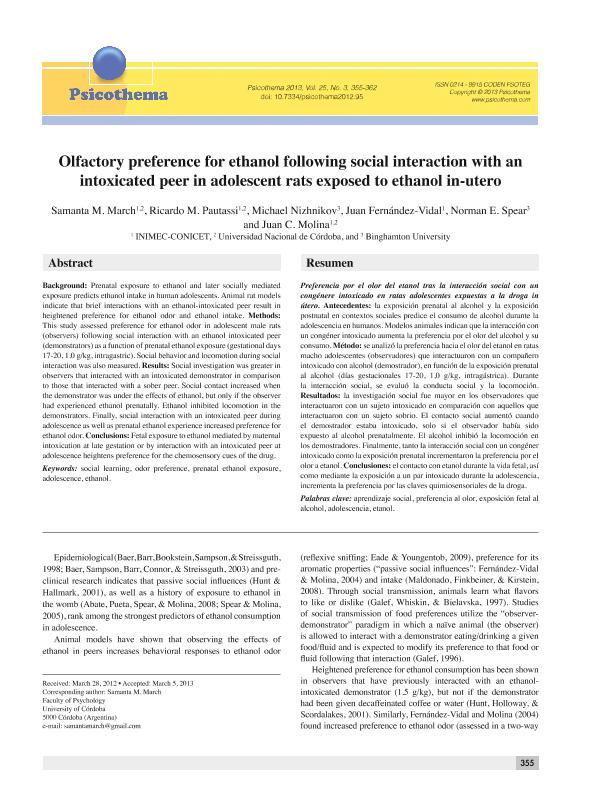Artículo
Background: Prenatal exposure to ethanol and later socially mediated exposure predicts ethanol intake in human adolescents. Animal rat models indicate that brief interactions with an ethanol-intoxicated peer result in heightened preference for ethanol odor and ethanol intake.
Methods: This study assessed preference for ethanol odor in adolescent male rats (observers) following social interaction with an ethanol intoxicated peer (demonstrators) as a function of prenatal ethanol exposure (gestational days 17-20, 1.0 g/kg, intragastric). Social behavior and locomotion during social interaction was also measured.
Results: Social investigation was greater in observers that interacted with an intoxicated demonstrator in comparison to those that interacted with a sober peer. Social contact increased when the demonstrator was under the effects of ethanol, but only if the observer had experienced ethanol prenatally. Ethanol inhibited locomotion in the demonstrators. Finally, social interaction with an intoxicated peer during adolescence as well as prenatal ethanol experience increased preference for ethanol odor.
Conclusions: Fetal exposure to ethanol mediated by maternal intoxication at late gestation or by interaction with an intoxicated peer at adolescence heightens preference for the chemosensory cues of the drug. Antecedentes: la exposición prenatal al alcohol y la exposición postnatal en contextos sociales predice el consumo de alcohol durante la adolescencia en humanos. Modelos animales indican que la interacción con un congéner intoxicado aumenta la preferencia por el olor del alcohol y su consumo.
Método: se analizó la preferencia hacia el olor del etanol en ratas macho adolescentes (observadores) que interactuaron con un compañero intoxicado con alcohol (demostrador), en función de la exposición prenatal al alcohol (días gestacionales 17-20, 1,0 g/kg, intragástrica). Durante la interacción social, se evaluó la conducta social y la locomoción.
Resultados: la investigación social fue mayor en los observadores que interactuaron con un sujeto intoxicado en comparación con aquellos que interactuaron con un sujeto sobrio. El contacto social aumentó cuando el demostrador estaba intoxicado, solo si el observador había sido expuesto al alcohol prenatalmente. El alcohol inhibió la locomoción en los demostradores. Finalmente, tanto la interacción social con un congéner intoxicado como la exposición prenatal incrementaron la preferencia por el olor a etanol.
Conclusiones: el contacto con etanol durante la vida fetal, así como mediante la exposición a un par intoxicado durante la adolescencia, incrementa la preferencia por las claves quimiosensoriales de la droga.
Olfactory preference for ethanol following social interaction with an intoxicated peer in adolescent rats exposed to ethanol in-utero
Título:
Preferencia por el olor del etanol tras la interacción social con un congénere intoxicado en ratas adolescentes expuestas a la droga in-útero
March, Samanta Mabel ; Pautassi, Ricardo Marcos
; Pautassi, Ricardo Marcos ; Nizhnikov, Michael; Fernandez Vidal, Juan Miguel
; Nizhnikov, Michael; Fernandez Vidal, Juan Miguel ; Spear, Norman E.; Molina, Juan Carlos
; Spear, Norman E.; Molina, Juan Carlos
 ; Pautassi, Ricardo Marcos
; Pautassi, Ricardo Marcos ; Nizhnikov, Michael; Fernandez Vidal, Juan Miguel
; Nizhnikov, Michael; Fernandez Vidal, Juan Miguel ; Spear, Norman E.; Molina, Juan Carlos
; Spear, Norman E.; Molina, Juan Carlos
Fecha de publicación:
07/2013
Editorial:
Universidad de Oviedo
Revista:
Psicothema
ISSN:
0214-9915
e-ISSN:
1886-144X
Idioma:
Inglés
Tipo de recurso:
Artículo publicado
Clasificación temática:
Resumen
Archivos asociados
Licencia
Identificadores
Colecciones
Articulos(INIMEC - CONICET)
Articulos de INSTITUTO DE INV. MEDICAS MERCEDES Y MARTIN FERREYRA
Articulos de INSTITUTO DE INV. MEDICAS MERCEDES Y MARTIN FERREYRA
Citación
March, Samanta Mabel; Pautassi, Ricardo Marcos; Nizhnikov, Michael; Fernandez Vidal, Juan Miguel; Spear, Norman E.; et al.; Olfactory preference for ethanol following social interaction with an intoxicated peer in adolescent rats exposed to ethanol in-utero; Universidad de Oviedo; Psicothema; 25; 3; 7-2013; 355-362
Compartir
Altmétricas



